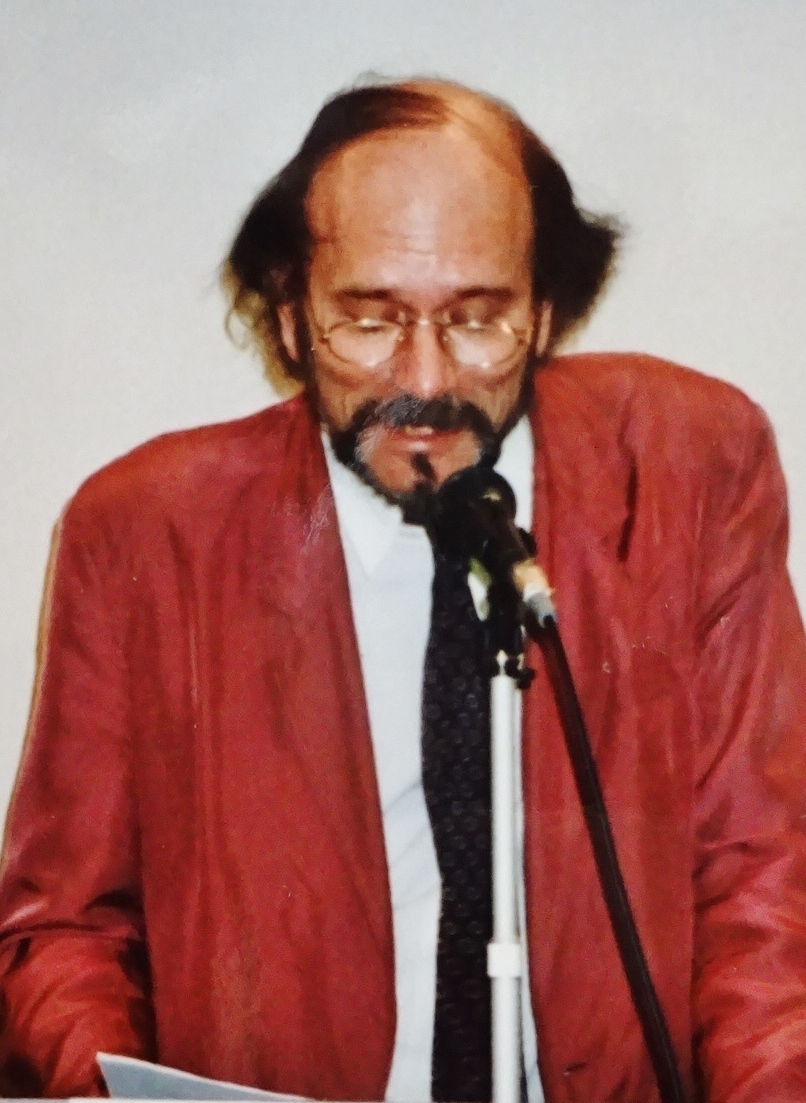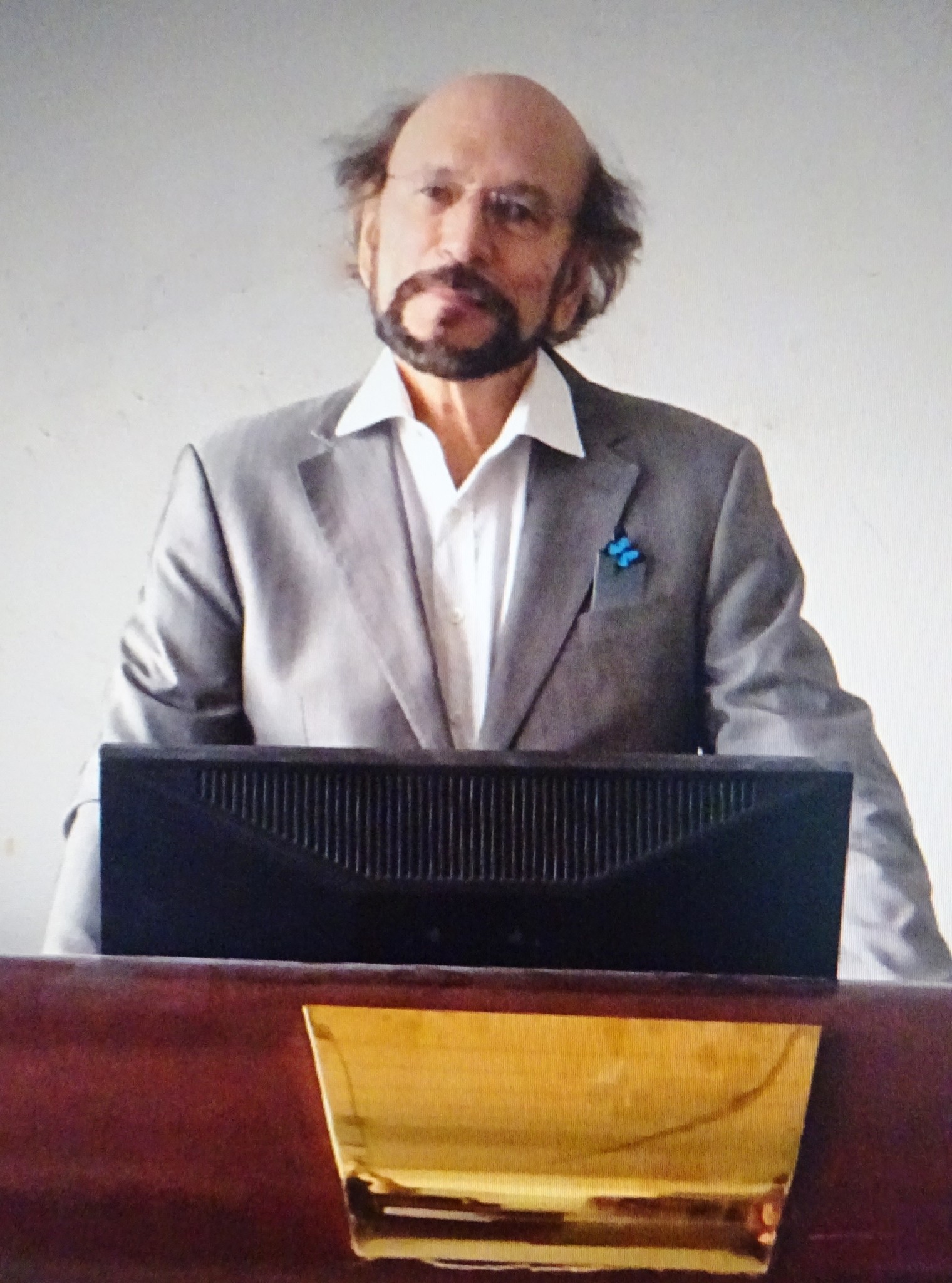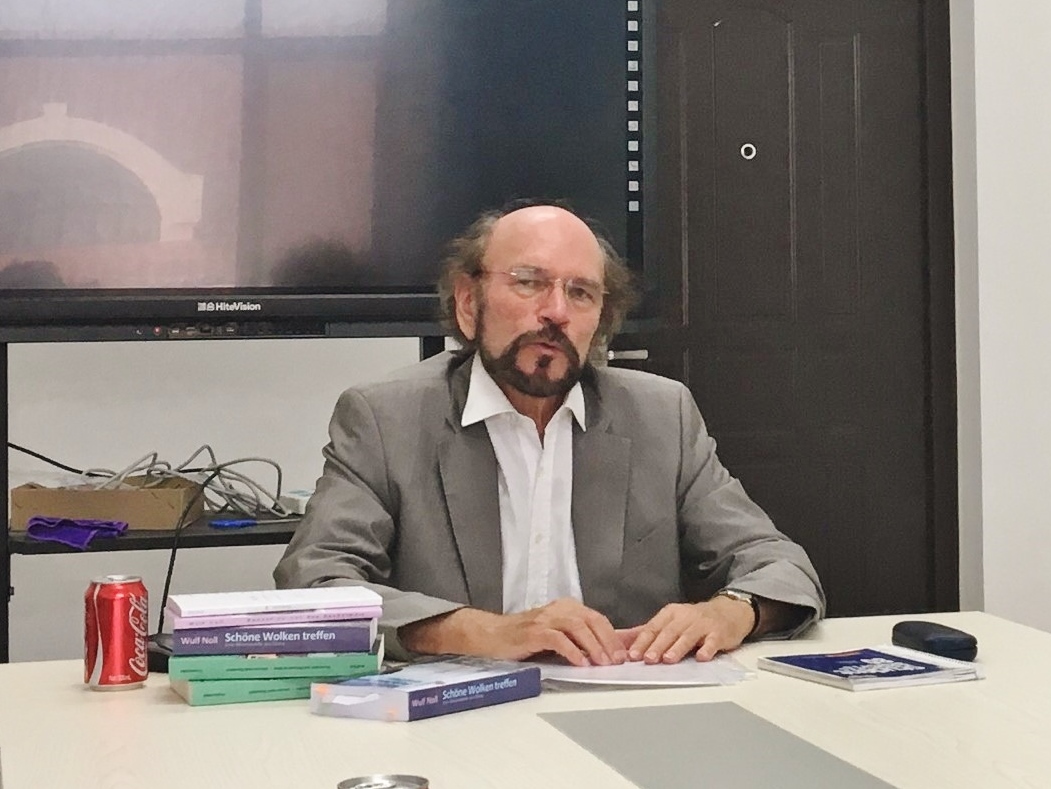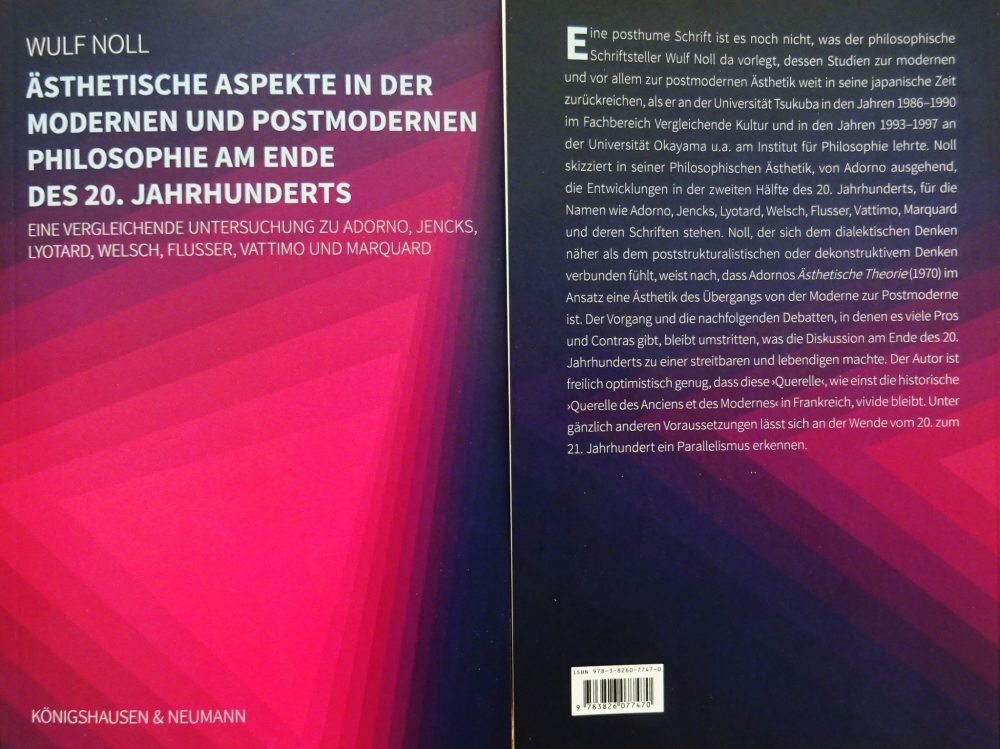Text: Heinrich Geiger and Wulf Noll | Section: Border-crossers
Overview: On the occasion of his new postmodern book, Wulf Noll is brought into play as a border crosser between philosophy and literature. Heinrich Geiger introduces this book in Part 1. Noll then gives a brief overview of his life and work.
Preliminary remarks by the editor of w/k
In w/k, those crossing the border between science and the visual arts are of particular interest; Herbert W. Franke and Karl Otto Götz have a prominent place. However, border crossers of other kinds are also recognised in the margins, e.g. Ira Seidenstein. “Ira Seidenstein is a professional clown, clown trainer and academic exploring the interface between science and the theatre stage (broadly defined): he is a lecturer, actor, performer, director and author.” Or Eva Verena Müller: both an actress and a scientist who is doing her doctorate on forest ecology.
On the occasion of his new postmodern book, Wulf Noll is now being brought into play as a crossover artist between philosophy and literature. Heinrich Geiger introduces this book in Part 1. After Noll has given a brief overview of his life and work, Part 2 consists of an interview with the border crosser between European and Asian cultures, with particular focus on Japan and China.
My personal connection to Noll should not go unmentioned. His philosophical dissertation Sloterdijk auf der ‚Bühne‘. Zur philosophischen und philosophiekritischen Positionsbestimmung des Werkes von Peter Sloterdijk im Zeitraum von 1978–1991 [Sloterdijk on the ’stage‘. On the philosophical and philosophical-critical positioning of Peter Sloterdijk’s work in the period 1978–1991] was supervised by me in the early 1990s and was published in 1993 by the Essen-based publishing house Die blaue Eule in the series Illusionstheorie – Ideologiekritik – Mythosforschung [Illusion theory – Ideology criticism – Myth research].
Heinrich Geiger: About Noll’s new postmodern book
2023 was published by Königshausen & Neumann (Würzburg) Aesthetic Aspects in Modern and Postmodern Philosophy at the End of the 20th Century. A comparative study of Adorno, Jencks, Lyotard, Welsch, Flusser, Vattimo and Marquard. In the 1980s and 1990s, aesthetics enjoyed a boom in Germany. It was a decade of intense debate, not only about how aesthetics should be practised, but what aesthetics is all about and why it is important.
It is precisely at that point that Noll’s writing begins. The author introduces the highly polyphonic and controversial debate on the matter of aesthetics from the perspective of a contemporary. His method is not one of musealisation, but also not that of harsh, direct destruction. How he deals with Theodor W. Adorno’s aesthetics of modernism, then takes up the aesthetic impetus from the architecture of Charles Jencks (the first effective theorist of postmodernism), Jean-François Lyotard’s progressivism and its turn to the sublime and, in the long final straight line of his essay the aesthetic dimension in the work of Wolfgang Welsch, the telematic aesthetics of Vilém Flusser and the postmodern criticism of Gianni Vattimo and Odo Marquard, is reminiscent of a game of Mikado that requires great skill and confidence. Little by little, stick by stick is taken away, but without creating a mess. Exactly the opposite is the case. The precision in the presentation is convincing.
For Noll, the conviction that aesthetics has to do with the particular in its particularity forms the guideline for his explanations. In doing so, he obviously avoids all theoretical generalisations. He explicitly opposes the claim to supremacy of aesthetics, which clings to certain metaphysical and other attempts at ultimate justification. His writing is based on the well-founded conviction that philosophical aesthetics should open itself up to the arts and also the non-arts (lifeworld, sensual experience, media), but only in such a way that it regenerates, expands and renews itself as aesthetics, without placing itself at the centre of the entire (intellectual, philosophical, scientific) process. Noll’s comparative study of Adorno, Jencks, Lyotard, Welsch, Flusser, Vattimo and Marquard (the subtitle of the work) is thus more than a primarily historically orientated treatise. It helps the reader to familiarise themselves with the event-oriented model of aesthetic perception (it is not for nothing that Noll devotes an entire chapter to Flusser’s aesthetics of the telematic) and, as in the chapter previously devoted to Welsch, to realise that aesthetics is to be understood as a theory of perception. Aesthetics does not have an autonomous dimension, but rather a constitutive function for all areas of action.
The philosophers named in the title of the book are analysed in their different approaches, which comprises the dispute between modernists and postmodernists, but also the differences in methods. Dialectics, post-structuralism, pluralism, hermeneutics and even phenomenology alternate methodically in the thinking of the philosophers discussed. Despite the divergent methods, the aesthetic structures of modern and postmodern aesthetics come into view, which in Noll’s study leads to a table of the differences between modernism and postmodernism by listing their characteristics on a content-related and formal level (279). It broadens the horizon and is beneficial that Noll not only pursues the theories, but also records what he has worked out using practical examples from art and literature, in art with Marcel Duchamp, Andy Warhol, Joseph Beuys, Daniel Buren, Christo and Jeanne Claude, and in literature with Umberto Eco and Italo Calvino.
Has the dispute between modernists and postmodernists now been resolved and/or come to a standstill at the end of the 20th century? With what result? There is much to be said in favour of stagnation and fatigue, but also in favour of finding one’s own positions. The literary-philosophical author speaks out in favour of postmodernism without wanting to offend modernism. Hitler’s Germany had threatened modernism and labelled it “degenerate”; fortunately, such times passed, modernism developed sufficiently well and has become classical. But even Adorno recognises an “ageing of modernity”, and he also knows the historical dispute. In historical retrospect, the Querelle des Anciens et des Modernes, initiated by Charles Perrault in the 17th century and continued at the turn of the 17th and 18th centuries, was of great importance. Perrault defended the moderns of his time against the ancients. Almost a hundred years later, Friedrich Schlegel spoke out in favour of the ancients and ended up with the moderns (the Romantics), Friedrich Schiller defended the moderns and ended up with the ancients (the classics). Such a dispute was not limited to Europe; it was conducted in China in the 18th century under Emperor Qianlong with regard to Chinese tradition under different cultural auspices. Ultimately, disputes between the ancients and moderns can be traced back to antiquity.
Jürgen Habermas, one of the harshest critics of postmodernism, saw the reaction taking over in ideological terms. Habermas was wrong. There was no fascism in the USA before or after the Second World War, which is why Jencks‘ temporary recourse to classicism cannot be blamed ideologically. Eclecticism is not the goal either; the architecture remains future-orientated; according to Jencks, it is modern and something different. Recourse to classicism, baroque, regionalism in architecture and the arts is not an end in itself, but continues a narrative by casting new eyes on the future and the past. It is not form follows function, but form follows fiction. The hospitals (Jencks) and prisons (Foucault) of modern architecture can and could be blown up, as happened in 1972 with the former new housing estates in Pruitt-Igoe in a symbolic act for the postmodernists. Incidentally, the late Jencks moved a little away from architecture by intervening artistically in landscapes and parks, remodelling them and attributing a special aesthetic appeal to nature through art.
The question remains as to how this work can be categorised. The author is primarily oriented towards phenomenology and dialectics, which does not exclude hermeneutic interpretations. Noll’s earliest involvement with aesthetics goes back to phenomenological aesthetics, especially to Moritz Geiger, who was one of Walter Benjamin’s teachers. Like Adorno, Geiger went into exile in America, but died there prematurely without completing his work. What also applies methodologically to Noll is the unprejudiced investigation of aesthetic and artistic phenomena and works. If there are nevertheless prerequisites, they can be found in Enlightenment thinking since Kant, in the economic Enlightenment since Marx, and above all in the psychological/psychoanalytic Enlightenment through and since Freud, which is overall one of the characteristics of the Frankfurt School, to which Noll feels connected. Without this enlightened approach, many people, including well-educated and educated philosophers, are fooling themselves.
As Adorno says, it should not speak against someone if they can write. Noll is a philosophical writer who has written travelogues, novels, essays and poetry. His great philosophical treatise thus also serves his own localisation, which becomes particularly clear when he turns to Eco and Calvino. Noll is particularly interested in Calvino’s idea of the hyper-novel, which contains elements of the artist’s novel and the Bildungsroman. The author, who taught and lived in Japan and China for a long time, is himself postmodern, as he favours a multi-perspective narrative style and refers to other cultures without forgetting his own starting point. For him, postmodern in this respect means: German/European and something else … India, Japan, China …
Let us conclude with a few keywords that can be used to characterise Noll’s work on philosophical aesthetics: end of modernity; productive dispute between moderns and postmoderns; play on words: modérn and módern (Welsch); continuation of the Enlightenment (Adorno) versus the end of the grand narratives of freedom and enlightenment as well as many small, colourful narratives (Lyotard); (k)ein Ende der Geschichte (against Fukuyama); everyone is an artist (Beuys); anything goes (but only if it is well done as a work of any kind); weak thinking as opposed to power-based thinking and the distortion (Verwindung) of modernity (Vattimo); aesthetic turn (Welsch); connection between science and art; telematic aesthetics/aesthetics of the telematic (Flusser); continuation of postmodernism and/or second postmodernism without ideological theatre.


Short biography
Wulf Noll is a literary-philosophical writer who was born in Kassel in 1944. He studied German literature, linguistics and philosophy in Göttingen, Berlin (West) and Düsseldorf. Magister Artium in Berlin, both state examinations, Dr phil. in Düsseldorf.
Noll worked intermittently at the following universities: University of Essen (1977–79), at the Japanese state universities Tsukuba (1986–90) and Okayama (1993–97), at the Chinese state university Ningbo (2009–11) and at the Ocean University of China in Qingdao (2017). In Düsseldorf, Noll was a teacher for integration for (Jewish) contingent refugees with an academic background from the CIS states from 1999–2009.
Noll has published twenty books, mainly focussing on Japan and China, as well as numerous shorter works, stories, treatises, essays and reviews on literature and art. These include specialist philosophical essays in university journals and in the academic journals minima sinica and Orientierungen. Wulf Noll is a member of PEN-Centre Germany and other literary and academic institutions and associations. He is interested in intercultural understanding, the perception of other cultures and communication.
Special honours: Participation in the Japan-EU Year of Encounters 2005, Prize of the State of North Rhine-Westphalia: Germany in Japan 2005/2006 (reading tour in Japan). 2017: Visiting professor/poet in residence at the Ocean University of China in Qingdao, Shandong Province.
Feature image above the text: Wulf Noll at the Ocean University of China, Qingdao (2017). Photo: Archive of the author.
Further information
▷ Wikipedia: https://de.wikipedia.org/wiki/Wulf_Noll
▷ LITon.NRW: https://liton.nrw/person/noll-dr-phil-wulf
▷ Publisher’s link to the book: https://verlag.koenigshausen-neumann.de/product/9783826077470-aesthetische-aspekte-in-der-modernen-und-in-der-postmodernen-philosophie-am-ende-des-20-jahrhunderts/
▷ Radio programme on the postmodern book: https://www.nrwision.de/mediathek/neues-aus-der-literaturstadt-duesseldorf-wulf-noll-schriftsteller-aus-kassel-240109/
Zitierweise
Julia Frese (1024): Wulf Noll. Part 1: Crossing the border between philosophy and literature. w/k - Zwischen Wissenschaft & Kunst. https://doi.org/10.55597/d19293



Gib den ersten Kommentar ab